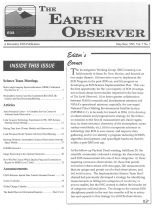The Earth Observer has a new look! Visit the NEW Earth Observer website.
The Earth Observer: May - Jun, 1995
In This Issue
Click title below to view page
Science Team Meetings
Multi-Angle Imaging Spectroradiometer (MISR) Calibration Peer Review II .... 3
Stratospheric Aerosol and Gas Experiment III (SAGE III) Science and Data Processing Meeting .... 7
Articles
Ames Research Center-A Complete Service Center for Airborne Earth Observation .... 9
Lidar In-space Technology Experiment (LITE) 1995 Science Steering Group Meeting .... 15
Mining Data from Climate Models and Observations .... 19
Land Processes DAAC Science Advisory Panel Meeting ... 24
Meeting Summary: Atmospheric Science Observations from the Space Shuttle .... 27
EOSDIS Version O ... 29
Image Processing in the Alaskan Classroom ... 30
How Will We Choose Which Quality Flags and Constraints to Report for MISR Level 2 Data? ... 32
Announcements
USGS Releases Spatial Data Transfer Standard Format..... 34
Science Calendar ..... 35
Global Change Calendar ... 35
The Earth Observer Information/Inquiries .... Back Cover
Editor's Corner
Michael King, EOS Senior Project Scientist
The Investigators Working Group (IWG) meeting was held recently in Santa Fe, New Mexico, and focused on two major themes: (i) innovative ways to implement the EOS Program in the post-2000 era, and (ii) progress on developing an EOS Science Implementation Plan. This was the first opportunity for the vast majority of EOS investigators to learn about recent studies (reported in the last issue of The Earth Observer): (i) to foster greater collaboration between NASA's research and development missions and NOAA's operational missions, especially the converged National Polar Orbiting Environmental Satellite System (NPOESS C-1), to be ready for launch in 2004, (ii) to develop an observational and programmatic strategy for the followon missions to the first 24 measurement sets (land vegetation, ice sheet elevation, chemistry of the stratosphere, ocean surface wind fields, etc.), (iii) to incorporate advances in technology into EOS to save money and improve data gathering, and (iv) to identify a program including EOSDIS, algorithm development, and spaceflight hardware that fits within a post-2000 cost cap.
At the follow-up Payload Panel meeting, held June 29, the scientific community endorsed a strategy for characterizing each EOS measurement into one of four categories: (i) those requiring continuous observations, (ii) those that permit intermittent observations with data gaps, (iii) measurements that are unique and permit one-of-a-kind observations, and (iv) initial science. The Implementation Science Team that I chaired had previously developed a strategy for identifying measurements as falling into categories of monitoring vs process studies, but the IWG wanted to define the broader set of categories outlined above. The charge to the various EOS disciplinary panels in the next few months will be to articulate and expand on this strategy for all EOS observations,...
Read more...

